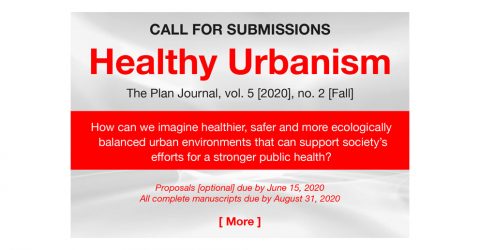
http://www.theplanjournal.com/content/call-submissions-%E2%80%93-vol-5-20-no-2-fall
If anything kills over 10 million people in the next few decades, it’s most likely to be a highly infectious virus rather than a war. … If we start now, we can be ready for the next epidemic.” (Bill Gates, 2015) 1
“Vast spaces with sun and air onto which all apartments open. Gardens and playgrounds at the foot of the houses. … Richness is provided by the breadth of the layout and by the play of vegetation over the geometric canvas of the facades…”
(Le Corbusier, 1920) 2
The public health crisis of historic proportions caused by the COVID-19 virus has uncovered the fragility not only of health care systems and public health policies world-wide, but also of the very nature of our urbanistic and habitat models. Dense metropolitan mega-cities, overstressed public transportation systems, work environments and housing designed and built without a proper concern for the health and well-being of people, have certainly been hindrances in tackling this global emergency. Without superficial dismissals of the value of dense and connected urban organisms and an equally superficial embracing of de-urbanization theories, it is reasonable to question whether to re-think widely accepted urban models, building typologies and infrastructure systems, as well as co-habitation dynamics between formal and informal settlements, in view of the lessons learnt from the COVID-19 pandemic. As Richard Sennett has put it: “This pandemic challenges urbanists to re-think the architecture of density … we are going to need new concepts about community and how to build it physically.” 3
As architects, designers and urbanists, we can do a great deal to create healthier and more just environmental conditions that can help prevent or mitigate the explosion of a pandemic on a scale such as the one of COVID-19.
Hence, what are the lessons that as architects, designers and urbanists we can learn from this experience, so that, with Bill Gates, “we can be ready for the next epidemic”? Does Corbu’s hundred-year-old vision bear new relevance vis-à-vis today’s challenges? How do we reconcile density with healthy social distancing without inducing social isolation? How can we make public transport safer? How do we re-balance priorities between public and private transportation infrastructures? What are the strategies to seek the help of healthier natural ecologies within our cities? How do we push the envelope of sustainability, at the urban and the building scale, beyond energy, to include standards for public health? What strategies can help address urban inequality to uphold “the right to the ‘healthy’ city”?
The TPJ wants to document innovative research studies that can address these and other related questions, from a variety of disciplinary and cross-disciplinary perspectives, in order to contribute to a broader societal effort in shaping up future healthier and safer urban environments.
Submission Options
Priority for peer-review evaluation and publication will be given to complete manuscripts, but proposals in the form of long abstracts [300/500 words] are also encouraged as a first step in the editorial review process. Authors of accepted proposals will then be invited to develop complete manuscripts, which will then go through the peer-review process.
Submitting proposals as a first step is only an option and full manuscripts are encouraged also as first submissions.
Timeline
Proposals [optional], about 500 words, due by June 15, 2020
Invitation to develop accepted proposals into complete manuscripts sent to authors by June 29, 2020
All complete manuscripts due by August 31, 2020
Accepted and edited manuscripts expected to be published on-line between November and December, 2020
Full digital issue and its printed version expected to be available by January 31, 2021
Questions Any question can be directed to: tpj@theplanjournal.com(link sends e-mail)
1. Bill Gates, TedTALK, March 2015: https://www.ted.com/talks/bill_gates_the_next_outbreak_we_re_not_ready?l…(link is external)
2. Le Corbusier, Toward an Architecture, intr. Jean-Louis Cohen, trans. John Goodman (Los Angeles: The Getty Research Institute, 2007; or. ed., Vers une architecture, 1924), 128.
3. Richard Sennett, “Density in the Wake of Social Distancing,” talk via Zoom, within the “100 Day Studio” series, The Architecture Foundation, London (April 9, 2020).
Massimiliano Aprili
Distribution, Fairs & Promotion
THE PLAN
Div. Architettura Design Ingegneria
Architecture Design Engineering Division
Maggioli Group
Via del Pratello, 8
40122 Bologna I
Direct +39 051 0087564
T +39 051 227634
@ www.twitter.com/theplanmag
In www.linkedin.com/company/the-plan
